Fescue is cereal plant actively used in landscape design. Many gardeners like this small bush because it forms dense sod-buds. that can bring new notes to the layout of the site. Let's take a closer look at this plant and its species: Gray, Paniculata, Filiform and others.
Fescue has been known to mankind since ancient Roman times, and it is from there that its name came. In nature, it can grow in any climate and on any soil., is found in steppes, meadows and forests located in areas with a harsh, temperate, subtropical or tropical climate.
The true meaning of the name of the plant, unfortunately, has been lost.
Fescue is a family of plants with a number of similar characteristics. O usually, they are dense, rounded small shrubs 10-20 centimeters high, but higher subspecies can also be found, whose sizes can reach 1.5 meters.
The leaves are quite narrow, depending on the type, they can be presented in two versions.:
- To slow down the evaporation of water, in most species, the leaves are folded in half, and in their appearance resemble thorns or needles;
- Most decorative varieties can boast leaves of a latent form with a width of 1.5-2 centimeters.
A distinctive feature of all species, regardless of the shape of the leaves, will be their hairiness or roughness, easily noticeable when stroking the plant.
Blooms in June. Its inflorescences are slightly spreading, they are panicles from 4 to 20 centimeters long, on which there are small spikelets and also flowers. Bottom part the inflorescence is covered with small scales and veins, the apex is sharp, with long stamens at the end. Spikelets are located on peduncles, the height of which is twice the height of the leaves. The fruit is a small grain.
This plant is quite unpretentious and does not require complex care.. This positive quality is due to the fact that in nature, fescue grows in a variety of areas and easily adapts to the climate and landscape features.
Types of fescue
Experts identify more than 150 species that differ from each other. For growing as an element landscape design use the following types:
Sizaya
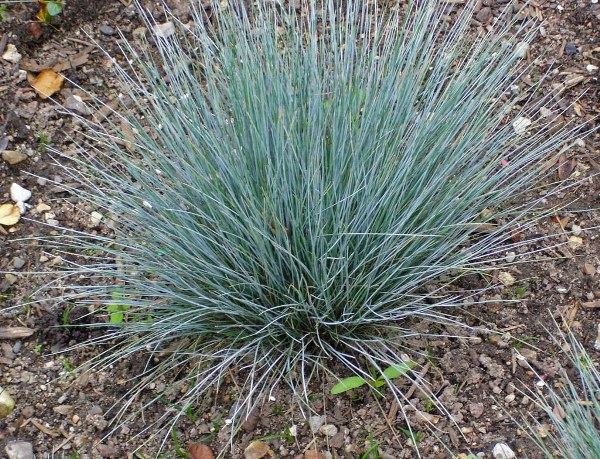
The most popular type. The gray fescue is a rounded turf, resembling a translucent, airy sphere. The leaves are very narrow, can grow up to 30 centimeters in length.. They evenly diverge from the center, creating a regular ball shape.
The color of the leaves, painted in a gray-blue, metallic color, gives this species a special charm. It should also be noted panicles of gray-green color, completing the composition. They seem to complement the leaves and create a radiant halo.
A certain shade of gray fescue leaves depends on the variety chosen. The subspecies Blue tussock, Lapis lazuli and Elijah Blue are especially popular.
Paniculata

Represents a short perennial no more than 10 centimeters high. The thin leaves of panicled fescue are bright green in color and are very close to each other, creating a dense cushion. If you do not control the growth of the turf, then it can grow to a huge size.
Panicles are very delicate and graceful, several times higher than the leaves. Against the background of dense greenery, they seem to be a weightless haze.
filiform

This species is a low, spreading bunch, consisting of rich green foliage, most of which lies on the ground. Peduncles grow twice as high as green, up to about 30 centimeters. Loose, mother-of-pearl-colored panicles are located on them, crowning the resulting composition.
amethyst
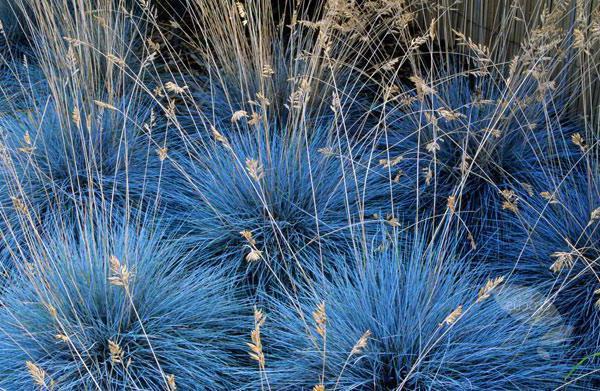
Amethyst fescue is considered one of the largest representatives of its family. The needle-shaped leaves folded in half form a perennial, rounded tussock, up to 50 centimeters high. This plant constantly grows in width, after a few years of life, its diameter can reach 1 meter..
Depending on the selected variety and growing conditions, the foliage can be painted in blue, silver, bluish or green color. Loose spikelets of purple-violet color are located on long peduncles and create a mysterious cloud around the plant.
Mayeri

This species boasts the most impeccable form of turf. Rigid leaves are collected in a dense, symmetrical, but at the same time airy tussock. On average, Mayeri's height is 70 centimeters..
The leaves of this species are glossy and needle-shaped, with a characteristic arcuate bend. Panicles are very large, spreading.
Siberian
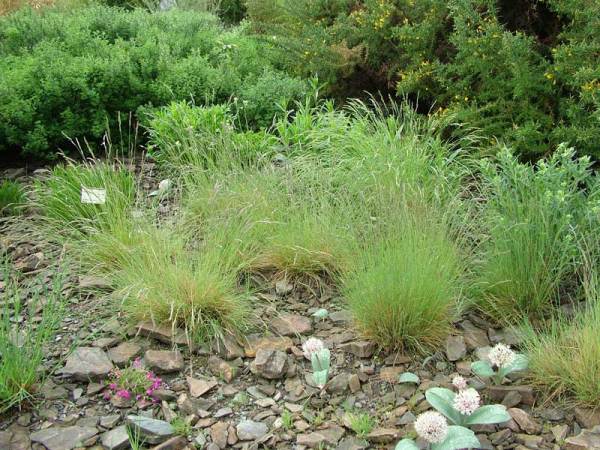
Thanks to the Siberian fescue, you can create a two-level design. The plant is a dense, spherical turf 30-40 centimeters high, which consists of leaves unusual for this family with a latitude of 8 centimeters. They are painted light green and curve slightly from the center.
Peduncles are arranged in such a way that they seem to repeat the lines of the first tier. Panicles are light and slightly spreading.
Growing conditions
Fescue is considered an unpretentious plant, and it can be grown under any conditions. But in order to most fully reveal the beauty of its beauty, choose a sunny site as a landing site, slightly elevated.
It is the sunny color and warmth that are the main factors in preserving the decorativeness of the fescue. The blue or metallic shade of the leaves can only be obtained under good lighting conditions.
It is also worth noting that these small bumps are not afraid of drafts, strong winds and heat.
Fescue is not demanding on the composition of the soil and can grow well on poor land with a meager content. nutrients. Rocky or sandy soils are best suited for this plant. An important condition will be the absence of stagnant moisture in the soil, because such a plant cannot tolerate dampness.. For safety net, it is desirable to build at the bottom landing pit quality drainage.
plant care
Fescue is not whimsical to care for, and growing it on your site is very simple. The plant is watered extremely rarely, 2-3 procedures are enough for the whole summer.. Among other things, the turf does not need to be fed and fertilized.

The main rule that every gardener should learn is timely pruning, namely the removal of dry leaves and faded panicles, and the flower stalks are cut not at the root, but to the level of greenery.
All species perfectly tolerate even the most severe winters, so they do not need additional shelter.. They also recover well after freezing during spring and return frosts.
reproduction
Usually, fescue is propagated by vegetative methods.
A distinctive feature of the rounded turf is that the central part of the plant begins to dry out after 2-3 years, so it needs private rejuvenation.
Work on rejuvenation and at the same time on the reproduction of fescue is carried out as follows:
- The best period for dividing a plant is considered early spring;
- First the bush is dug up and divided into 2-3 divisions, while disconnecting the dry center;
- Each resulting part must be endowed powerful bunch of roots;
- The final step will be plant transplant to a permanent place.

Another method is called the division of uterine bushes. It is used when it is necessary to obtain a large amount planting material :
- Early to mid October an adult and healthy bush is transplanted into a pot and leave to winter in a bright and dry place with an air temperature of 3-5 degrees;
- In February, the plant is divided into several small parts, each of which must have growth points;
- The resulting delenki placed in large containers or boxes and grow them there until the weather is favorable for transferring them to open ground.
In addition to the basic rules for reproduction, every grower should know that it is much easier to perform such work with a sharp garden tool.
Diseases and pests of Fescue
This is one of the rare plants with strong immunity to almost all diseases. It is also almost impossible to meet pests on it.
When growing Fescue, you may encounter problems such as root rot and helminthosporium. caused by the accumulation of various kinds of fungi. AT last case brown mesh spots appear on the leaves.

These two diseases are united by the fact that with their formation it is already impossible to cure the plant, in any case it will have to be removed and burned. The main cause of rotting or fungus is stagnant moisture and excessive soil moisture.. Therefore, the main preventive measure when growing sod, there will be maintenance of the correct, that is, a rare irrigation regime.
Fescue is very unpretentious, at the same time unusual and beautiful plant able to decorate any compositions. A nice bonus for both beginners and experienced florist there will be no complex schemes for caring for the bush.
Perennial plant 20 cm-1.4 m in height. Leaf blades of fescue are from wide linear to narrow. Panicles slightly spreading; spikelets 1.5 cm long, with flowers; lower scales lanceolate, shortly hairy or glabrous, with inconspicuous veins, rounded on the back, sharp at the apex.
More than 150 species of the Fescue genus, both mesophilic plants of forests and meadows, and xerophilic species typical of the steppes, distributed in almost all non-tropical zones of our planet.

Species and varieties
This genus includes many species of different appearance. Some types of fescue are used as a lawn plant.
The mountains of Transcaucasia and Central Europe are considered to be their homeland.
Large blue fescue. Forms a rounded tussock with flowers 60 cm tall. The leaf of this fescue is needle-like, round in section, the texture of the foliage is pleasant.
Amethyst fescue is an evergreen perennial with foliage that ranges from bluish-green to blue-gray.
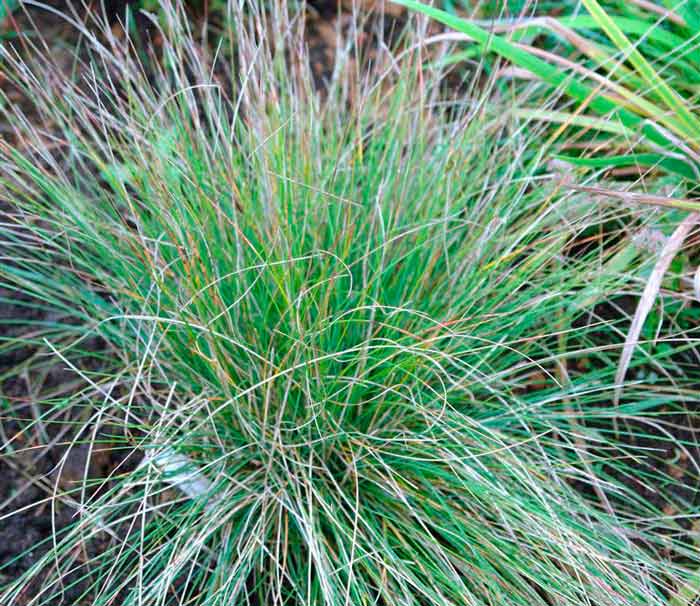
Amethyst fescue blooms in June, its flowers rise high above the foliage on thin stems. Flower panicles are green-violet. The bush forms dense cushions, which can form a curtain up to 1 m in diameter by 10 years.
Amethyst fescue grows well on light, poor, sandy soils, does not tolerate stagnant water. It must be planted in a sunny location - on a rocky hill, on a lawn. In the shadows, all beauty is lost.
The more sun it gets, the better it grows. The flowers are small, in straw-colored panicles, not decorative, it is recommended to cut them to exhaust the plant.
For seeds, you can leave a couple of panicles on a large curtain. In severe winters, the foliage of amethyst fescue can freeze out, but quickly recovers.
Glacial fescue
This fescue comes from the Pyrenees.
Plant 30 cm tall. Creates hemispherical, bluish cushions near the glacier zone. Used in rock gardens. In severe winters, it freezes slightly, but it recovers well. Glacial fescue reproduces by division and seeds.
Low perennial plant (together with spikelets up to 15 cm tall). Panicled fescue has light green graceful foliage up to 8 cm tall. It blooms at the end of June. Over time, it creates large cushion-like thickets. Grows well in a sunny location, but also suitable for shady places. Propagated by division of large specimens in spring or autumn.

Panicled fescue is an evergreen plant, but sometimes after winter most of the leaves die off, then they must be cut in early spring and grow back quickly. The decorativeness of panicled fescue is quickly restored.
The natural habitat is the European part of Russia, Western Europe, the Volga region, as well as Siberia.
Loosely soddy plant; thin stems, triangular at the top. The foliage is bristle-shaped, long, thin, winding. Panicles oblong, loose, often drooping. Spikelets of sheep's fescue are light green.
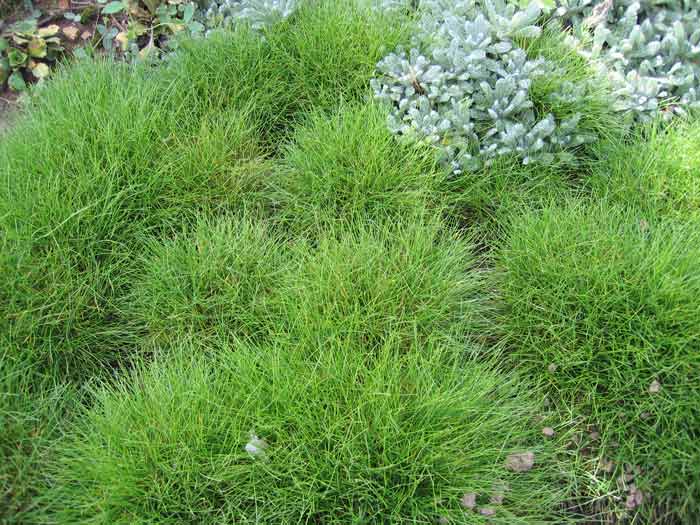
It is used for borders, for paths, near water.
Sheep fescue is an indispensable lawn plant for poor and dry soils. Her root system penetrates deep into the ground. Tolerates trampling and mowing 3.5 cm. Grows well under pine trees.
Gray fescue grows in Central Europe, Ukraine, the Baltic states, the Caucasus, and also the Urals.
Perennial herb with bluish-gray foliage. Forms a lush semicircular bush up to 60 cm tall. The leaf is linear, narrow, from grayish-green to blue.
The inflorescences of this fescue are gray-green, in panicles, after flowering they are light brown. Gray fescue blooms in June. This fescue is planted in dry places so that the silver color brings revival to the garden composition.

Heat-loving species, prefers permeable, sandy-humus, drained soils, as well as sunny places. Divide after 4 years. For intense coloring of the foliage, it is recommended to replant every 2 years.
It is often used as a groundcover, and it is necessary to keep all specimens in good shape, which is very difficult. Some may die off or fall out after a couple of years of growing in one place, so you should always have a stock of planting material in order to replace non-decorative specimens.
Gray fescue has a huge number of varieties. They differ in color, sometimes quite slightly. Some varieties are bluer, while others are more silvery. They also differ in their height.
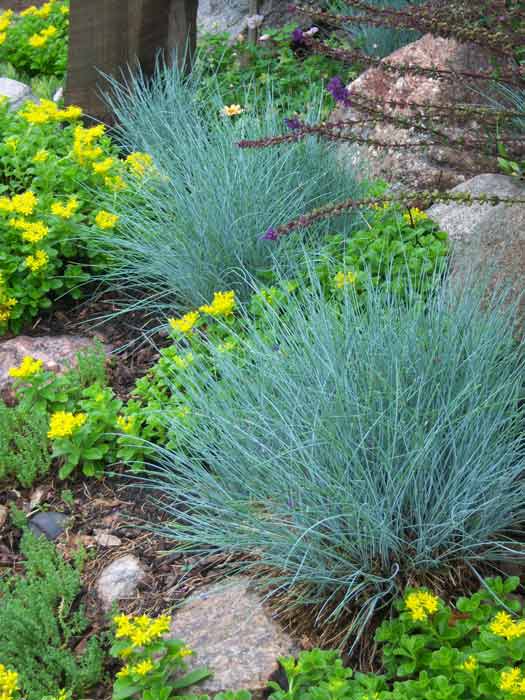
Fescue location
Grows best in a warm, dry place. Young specimens are cold-resistant, but in the third year of life they grow and die from the center of the turf.
soil for fescue
Prefers dry, loosened, low nutrient content. The plant does not tolerate wet soil, so good drainage is needed.

Fescue Care
In the spring, it is necessary to clean the bush from lagging leaves. Cut the panicles after flowering. Some forms of fescue may not be hardy, so when buying planting material, choose plants that have been grown under conditions similar to yours.
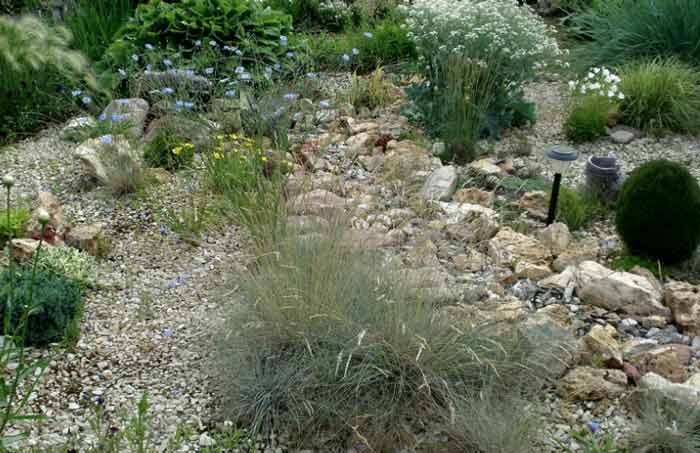
Fescue breeding
In the spring, dividing the bush.
The use of fescue
Today, fescue in Russia is one of the most common cereals in landscaping. She is planted in flower beds, in borders, mixborders, borders.
Gray fescue is probably the only ornamental grass used to form carpet flower beds. It can also be planted in arrays near shrubs, lawns, as well as with flowering letniki - in baskets. Often, gray fescue is grown in rock gardens.

Fescue Partners
Felt Yaskolka, bells, spikelet veronica.
Fescues are planted in the form of an array next to low plants, for example, hostas, geyhera, cuffs, lungwort, tradescantia, or next to large tapeworm plants, for example, miscanthus, volzhanki, creating a bluish-silver background, against such a background, large-sized plants will look more impressive .
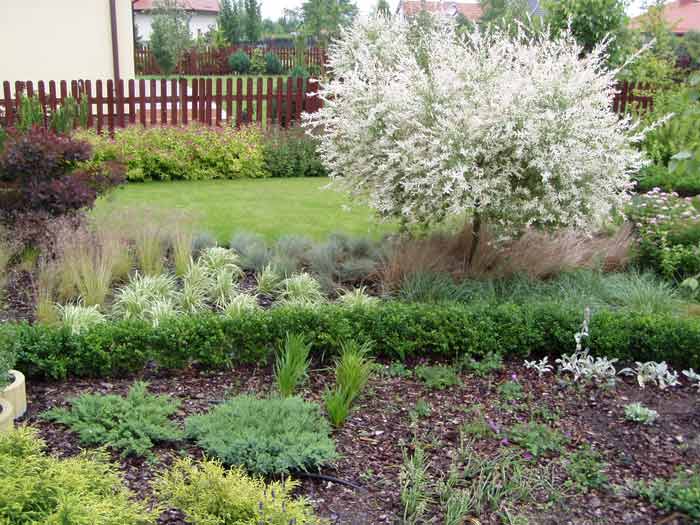
Gray fescue is widely used as a decorative element in the garden. Due to its unusual color, this plant has another name - blue bush.
Description
Fescue is a cereal perennial grass with about 300 species. It grows mainly in the temperate and subtropical climate zone. The homeland of the plant is the Caucasus, the Baltic states, the countries of Central Europe. The most popular among gardeners is gray fescue, planting and caring for which are not particularly difficult. This "humble" representative of the flora helps to give the garden a wonderfully beautiful look.
Small bushes of this plant, whose height varies from 25 to 40 cm, are covered with evergreen narrow leaves. Their color can be different - from gray to deep blue. In June, flowers appear in the form of spikelets-panicles, which at first have a blue-green color and, gradually fading, become almost brown. The seeds that form at the site of the inflorescences are very small - up to 700 pieces can be counted in 1 gram. With the onset of cold weather, the color of fescue becomes paler.
Growing conditions
Gray fescue prefers places that are dry, warm and well lit by the sun. But it also tolerates partial shade well. The most suitable soils for this plant will be sandy-humus, loose, breathable and well-drained, with little nutrient content. When choosing a landing site, damp areas where stagnant water is possible should be avoided.
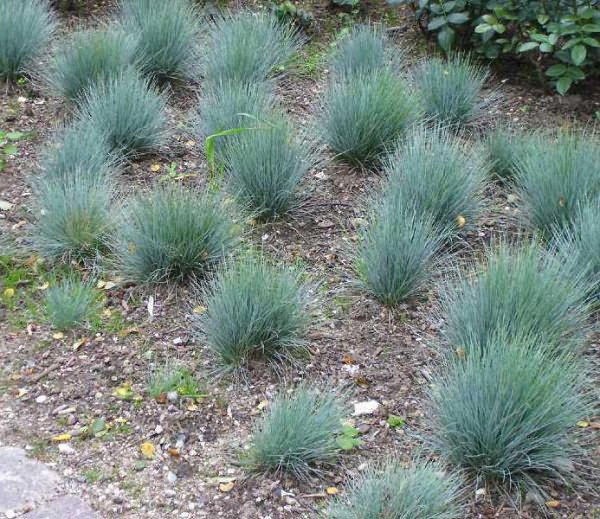
Fescue grows best in warm weather. The optimum temperature for it is from 19 to 27⁰С. Fescue tolerates dry and hot days very well. Young plants have higher frost resistance; with age, the ability to withstand colds decreases significantly.
reproduction
You can grow fescue different ways- seeds, dividing the bush or seedlings. After flowering, the largest spikelets are harvested and, after drying, the seeds are removed from them. They can be immediately sown in the ground already late autumn or in the spring when warmer weather sets in. So that in the future the gray fescue looks like a beautiful and fluffy bump, the seeds are sown in nests.
For the seedling method, you will need small boxes filled with a light substrate. In them, seeds are sown directly on the surface of the soil, without sprinkling, then watered, covered with glass or film and placed in a warm place well lit by the sun. After about a few days, the first shoots appear.

So that the seedlings do not stretch too much, as soon as the seeds sprout, the box is placed in a cooler place. When two leaves are formed on seedlings, they are placed in separate pots. By May, it will be ready for planting in open ground strong seedlings if sown seeds no later than mid-March.
Gray fescue can successfully reproduce by dividing the bush. This is done in the fall or spring when the plant reaches two years of age.
Landing and care
Sowing seeds in open ground is the most in a simple way growing fescue. To do this, 5-8 seeds are immediately placed in a planting hole no larger than 5 cm. The pits are located at a distance of 10 cm from each other, making about five nests in this way, each of which is sprinkled soil mixture and watered. After 2-3 weeks shoots already appear, which after 6 months turn into a lush bump.
A completely unpretentious plant is gray fescue. Planting and caring for it in the future are quite simple. The main thing is not to get involved in watering. It should be carried out as needed so that the soil is not too wet or dry.
Care mainly consists in pruning the dried parts of the plant. It is recommended to divide the bush every 2 years and transplant to ensure more lush flowering.
Advantages and disadvantages
Gray fescue is of great importance as a garden decoration. Growing it is quite simple, even a novice grower can do it. It is a very hardy plant that can withstand high temperatures air, which greatly facilitates maintenance. In addition, fescue is undemanding to soils and tolerates the presence of lime in them well.

The disadvantages include poor frost resistance, the inability to grow this plant in shaded and damp areas. Periodic division of the bush for the purpose of renewal, which is required for a plant such as gray fescue, makes caring for large plantings more laborious.
Varieties
There are several varieties of this plant, which differ slightly from each other in color and height. For example, Azurit, Blausilber, Silberreiher have a silver-blue leaf color, and the Meerblau variety is distinguished by a shade of sea water. Among flower growers, Festuca cinerea is the most popular, which forms a rather large lush bush up to 60 cm in size, covered with blue-green narrow leaves.
Application in landscape design
In gardens, fescue is used primarily as a groundcover. Most of all, it is suitable for planting in compositions, where it is a background or addition. Despite the fact that it is an evergreen grass, in spring it cannot always please with its appearance. Individual bushes may turn yellow during a frosty winter, and this leads to a loss of decorativeness of the area where gray fescue grows. To replace the withered parts of the plant, you always have to have a stock of planting material in such a case.
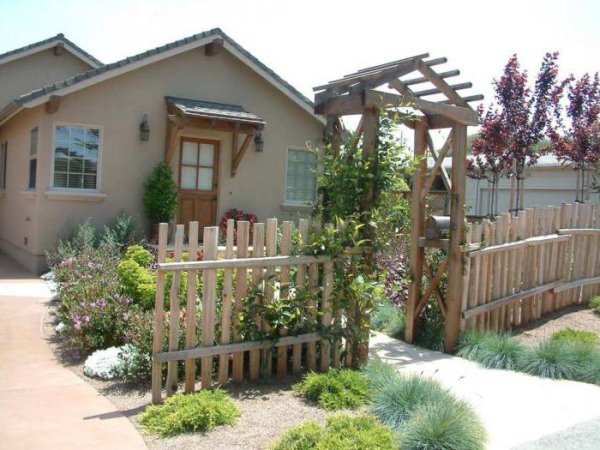
Fescue looks great in the neighborhood with more tender horticultural crops, such as violet and echinacea, when the composition is based on a fusion of orange, gray and purple hues. Interesting options can be picked up using honeysuckle, sea buckthorn or wormwood along with fescue.
AT garden design this plant is versatile. You can use it to beautifully decorate borders, rockeries, alpine slides.
Fescue looks very original against the background of boulders or gravel dumping. It goes well with such perennials as lungwort, cuff, Carpathian bell. Beautiful, bluish-blue balls of fescue, with their needle plumage resembling sea urchin, so they make sure to draw attention to themselves.
syl.ru
Fescue: planting and care, types, photos.
Perennial plant 20 cm-1.4 m in height. Leaf blades of fescue are from wide linear to narrow. Panicles slightly spreading; spikelets 1.5 cm long, with flowers; lower scales lanceolate, shortly hairy or glabrous, with inconspicuous veins, rounded on the back, sharp at the apex.
More than 150 species of the Fescue genus, both mesophilic plants of forests and meadows, and xerophilic species typical of the steppes, distributed in almost all non-tropical zones of our planet.
Species and varieties
This genus includes many species of different appearance. Some types of fescue are used as a lawn plant.
Amethyst fescue
The mountains of Transcaucasia and Central Europe are considered to be their homeland.
Large blue fescue. Forms a rounded tussock with flowers 60 cm tall. The leaf of this fescue is needle-like, round in section, the texture of the foliage is pleasant.
Amethyst fescue is an evergreen perennial with foliage that ranges from bluish-green to blue-gray.
Amethyst fescue blooms in June, its flowers rise high above the foliage on thin stems. Flower panicles are green-violet. The bush forms dense cushions, which can form a curtain up to 1 m in diameter by 10 years.
Amethyst fescue grows well on light, poor, sandy soils, does not tolerate stagnant water. It must be planted in a sunny location - on a rocky hill, on a lawn. In the shadows, all beauty is lost.
The more sun it gets, the better it grows. The flowers are small, in straw-colored panicles, not decorative, it is recommended to cut them to exhaust the plant.
For seeds, you can leave a couple of panicles on a large curtain. In severe winters, the foliage of amethyst fescue can freeze out, but quickly recovers.
Glacial fescue
This fescue comes from the Pyrenees.
Plant 30 cm tall. Creates hemispherical, bluish cushions near the glacier zone. Used in rock gardens. In severe winters, it freezes slightly, but it recovers well. Glacial fescue reproduces by division and seeds.
Panicled fescue
Low perennial plant (together with spikelets up to 15 cm tall). Panicled fescue has light green graceful foliage up to 8 cm tall. It blooms at the end of June. Over time, it creates large cushion-like thickets. Grows well in a sunny location, but also suitable for shady places. Propagated by division of large specimens in spring or autumn.
Panicled fescue is an evergreen plant, but sometimes after winter most of the leaves die off, then they must be cut in early spring and grow back quickly. The decorativeness of panicled fescue is quickly restored.
Sheep fescue
The natural habitat is the European part of Russia, Western Europe, the Volga region, as well as Siberia.
Loosely soddy plant; thin stems, triangular at the top. The foliage is bristle-shaped, long, thin, winding. Panicles oblong, loose, often drooping. Spikelets of sheep's fescue are light green.
It is used for borders, for paths, near water.
Sheep fescue is an indispensable lawn plant for poor and dry soils. Its root system penetrates deep into the ground. Tolerates trampling and mowing 3.5 cm. Grows well under pine trees.
gray fescue
Gray fescue grows in Central Europe, Ukraine, the Baltic states, the Caucasus, and also the Urals.
Perennial herb with bluish-gray foliage. Forms a lush semicircular bush up to 60 cm tall. The leaf is linear, narrow, from grayish-green to blue.
The inflorescences of this fescue are gray-green, in panicles, after flowering they are light brown. Gray fescue blooms in June. This fescue is planted in dry places so that the silver color brings revival to the garden composition.
Heat-loving species, prefers permeable, sandy-humus, drained soils, as well as sunny places. Divide after 4 years. For intense coloring of the foliage, it is recommended to replant every 2 years.
It is often used as a groundcover, and it is necessary to keep all specimens in good shape, which is very difficult. Some may die off or fall out after a couple of years of growing in one place, so you should always have a stock of planting material in order to replace non-decorative specimens.
Gray fescue has a huge number of varieties. They differ in color, sometimes quite slightly. Some varieties are bluer, while others are more silvery. They also differ in their height.
Fescue location
Grows best in a warm, dry place. Young specimens are cold-resistant, but in the third year of life they grow and die from the center of the turf.
soil for fescue
Prefers dry, loosened, low nutrient content. The plant does not tolerate wet soil, so good drainage is needed.
Fescue Care
In the spring, it is necessary to clean the bush from lagging leaves. Cut the panicles after flowering. Some forms of fescue may not be hardy, so when buying planting material, choose plants that have been grown under conditions similar to yours.
Fescue breeding
In the spring, dividing the bush.
The use of fescue
Today, fescue in Russia is one of the most common cereals in landscaping. She is planted in flower beds, in borders, mixborders, borders.
Gray fescue is probably the only ornamental grass used to form carpet flower beds. It can also be planted in arrays near shrubs, lawns, as well as with flowering letniki - in baskets. Often, gray fescue is grown in rock gardens.
Fescue Partners
Felt Yaskolka, bells, spikelet veronica.
Fescues are planted in the form of an array next to low plants, for example, hostas, geyhera, cuffs, lungwort, tradescantia, or next to large tapeworm plants, for example, miscanthus, volzhanki, creating a bluish-silver background, against such a background, large-sized plants will look more impressive .
flo.discus-club.ru
Verbena: types and varieties, planting and care, photo.
Description of verbena
How many among the flowers are those that give us beauty, while remaining little known. Such is the vervain. It was known in antiquity, but how medicinal plant and now few know her. Gardeners paid attention to it in the 19th century, when several types of verbena were brought from tropical and subtropical regions of America.
It can be assumed that when these types of verbena were grown in gardens, they were cross-pollinated and appeared the new kind- verbena hybrid. It is a perennial plant cultivated as an annual.
Verbena is a strongly branched plant up to 45 cm high with tetrahedral stems and opposite leaves of an elongated triangular shape, serrated along the edges. All green parts are pubescent with hard gray hairs.
Verbena roots are fibrous. The flowers are carnation-shaped, fragrant, collected 30-50 in corymbs 6-10 cm in diameter. The color is white, pink, fiery red, carmine, light blue, deep purple, one-color or with an eye of a different color.
Types and varieties of verbena
grandiflora- plants erect, 40-45 cm high, or creeping.
compact- plants recumbent with rising ends of the stems.
Plants attracted attention primarily with bright juicy colors, especially red, blue and purple. Varieties differ in height (20-50 cm), bush structure and flower size.
In addition to this type, there are several more types of verbena that are used for decoration, and especially for balconies and vases. This is Canadian verbena and hard verbena.
The first species blooms with light crimson flowers, the second with lilac-pink flowers. Verbena Buenos Aires is good for bouquets, which grows up to 1 - 1.2 m and has amethyst-colored flowers.
All types of verbena are cold-resistant and drought-resistant. Best Places for them - balconies on the south and southeast sides, ridges or vases near the house on the sunny side.
Bright vervain inflorescences are good for bouquets, especially since they remain in water for about 10 days. Low-growing, pure-color varieties are great for creating borders along paths, along the edge of prefabricated flower beds and discounts.
For group plantings, it is better to use samples of the same color. Verbena is undemanding to soils and does not tolerate fresh organic fertilizers at all, giving many shoots, but without flowers.
Varieties of verbena hybrid
Defiance- red flowers, blooms from early July, plant height 30 cm
Julia- violet-purple flowers with a white eye, blooms in June, plant height 40 cm
Cardinal- bright red flowers, blooms from July, plant height 40 cm
Etna- red flowers with a white eye, blooms from May, plant height 50 cm
compact verbena
Amethyst- blue flowers, blooms from July, plant height 30 cm
Dazler- bright red flowers, blooms in June, plant height 25 cm
Crystal- boiled white flowers, blooms from the end of June, plant height 20 cm Pink Delight
Splendor- purple-violet flowers with a white eye, blooms from July, plant height 20 cm
Growing and propagating verbena
All types of verbena are perennials grown as annuals. Propagated by seeds, sowing them in March for seedlings.
Seeds (they are collected gradually, as the faded inflorescences turn brown; germination lasts 1-2 years) germinate for a long time (10-20 days) and unfriendly. To accelerate germination, it is advisable to soak them in a growth stimulator (for example, in humate).
Verbena also cuts well. Seedlings are very sensitive to excess moisture, so they are sprayed only when the soil dries out. Seedlings dive only after a month. Planted in open ground in mid-May at a distance of 20-25 cm.
Verbena bloom in June and bloom all summer and early autumn, withstanding frosts down to -2-3 °C. Mineral supplements both in seedlings and in a permanent place, they help to get powerful plants and abundant flowering.
Vervain diseases
Verbena is affected by bacterial wilt, blackleg, root and stem rot and leaf spot caused by fungi and nematodes.
flo.discus-club.ru
Blue fescue - Plants for green roofs
Decorative blue fescue an excellent choice for those gardeners who prefer plants of unusual species with which you can create an unforgettable composition. Spherical lush shape and narrow needle-shaped leaves of a bluish hue, which even in winter period do not lose their own attractiveness.
What is blue fescue good for?
Blue fescue in adulthood is a spherical hummock up to 35-40 cm high. Everyone knows that fescue is grown mainly for decorating ridges, mixborders and rock gardens. Undoubtedly, it is worth mentioning that the spherical blue fescue on flat lawns undersized shrubs, about small artificial reservoirs and around large single landings. I would like to emphasize that, thanks to the beautifully colored foliage, fescue is used in city parks to create beautiful flower beds and mosaic panels.
blue fescue care
Fescue is unpretentious, grows well in warm areas with abundant sunlight. If the plant does not have enough sun, the leaves will turn greenish, and the blue fescue will lose its natural decorative look. Fescue begins to bloom in June and blooms until the end of the season, releasing longish gray-green peduncles-ears with a lilac color.
The fescue prefers light, breathable, low-nutrient and well-drained soil. Fescue has a mountain-alpine origin.
How is blue fescue propagated?
Fescue can be propagated various methods: seed, seedling and division of the bush. Blue fescue seeds are very easy to purchase in a store, or you can collect them on your own from an adult plant. I must say that when flowering, fescue forms panicle inflorescences. Imagine the fact that the largest and finest of them must be thrown in order for the seeds to ripen. Please note that after the plants have faded, the spikelets are harvested, dried and removed from their seeds.
Fescue is sometimes grown by seedlings, planting seeds in small boxes. A light substrate is suitable for planting. Please note that the seeds are sown on the surface of the earth and do not sprinkle. In other words, they themselves grow into the ground with sharpened tips. Usually crops are watered with settled water, covered clear glass and put in a warm sunny place.
Still, using decorative cereals, like blue fescue, it is easy to create various compositions in the garden. The plant is perfectly preserved in dried form and is used to make unique winter bouquets. Create unforgettable beauty on your site!
tags:sadnakrishe.com
AT MY DACHKA ... GLACIER FESTRUCTURE "Titmouse" - Festuca glacialis la
Low perennial grass with blue-gray leaves. It forms a lush semicircular bush 30-40 cm high. The leaves are narrow linear, bluish-green. Inflorescences are grey-green, in soft panicles on a straight stem, becoming grey-brown after flowering. It blooms in June - July (I have already bloomed). They plant it in dry places or in heather thickets so that its silver color brings revival to the composition of the site. The plant is thermophilic, prefers sandy-humus, permeable, well-drained soils and sunny places. After 3-4 years, the plant should be divided (I will do this next year).
For a more intense leaf color, it is recommended to replant every two years (this is in my plans for the next week). In cold years does not give a bright color. Sowing is done in May, after warming up the soil. Seeds are lightly sprinkled with earth, compacted well and watered. After the emergence of seedlings (after 15-20 days), they are thinned out or planted, maintaining a distance between plants of 25-30 cm.
I got five plants from the bag. Four survived. The first year it was frail, nondescript panicles-blades of grass. This year I cut them, fed them and they became such lush bumps. Part I will transplant to the alpine hill.
Fescue in composition
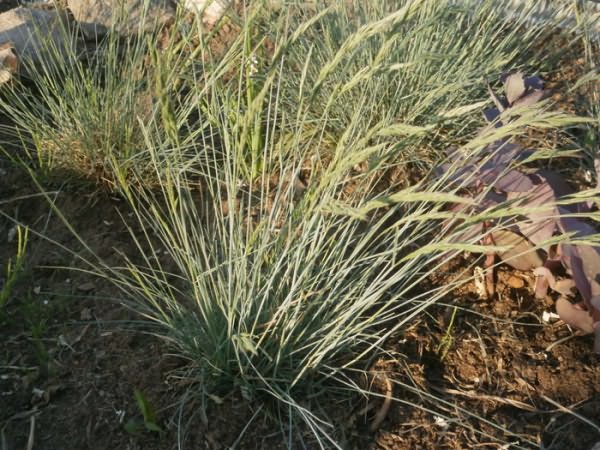
Spikelets close-up 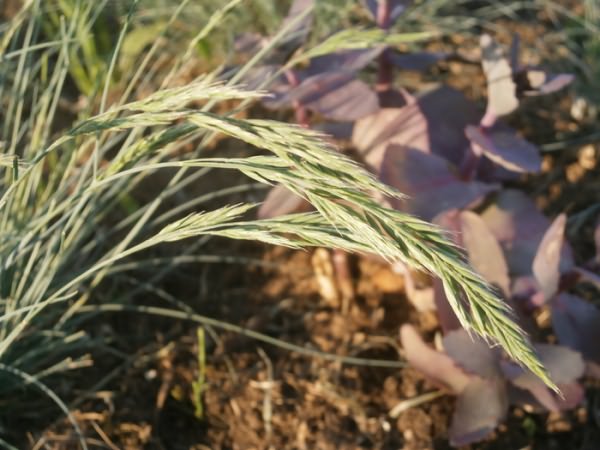
Until we meet again, friends!
An unusual plant, gray fescue, is a compact, spherical, undersized bushes. The main advantages of the culture, which determined its decorative purpose, are the original shape and exotic color of the leaves. And given the endurance and unpretentiousness of culture, this garden cereal is rightfully considered the leader in the design of landscape compositions and flower beds.
About how to grow beautiful fescue curtains on your site and what minimal care is required, read in detail in the material presented.
Gray fescue, plant description
- Fescue belongs to the herbaceous plants of the Cereal family. This perennial in nature is most often found in forest and meadow zones. hardy and unpretentious plant, fescue, is most common in temperate and subtropical climates. Although in recent times, the area of distribution of culture is increasing exponentially, reaching both cold climatic regions and hot tropics.
- Ornamental herbaceous culture is adapted to different types soils. Dry and poor in composition soils are no exception. Moreover, the worse the soil, the better the fescue feels on it. This valuable quality makes it very easy for many gardeners to care for this exotic crop.
- Gray fescue is the most popular species of this genus. The culture got its name due to the bluish-gray (gray) color of the leaves. Although, with the onset of cold weather, the color of the leaves brightens and turns pale, the attractive decorative appearance practically does not suffer from this. Other names of gray fescue are also known - blue or ashen fescue, also displaying the original color of the plant.
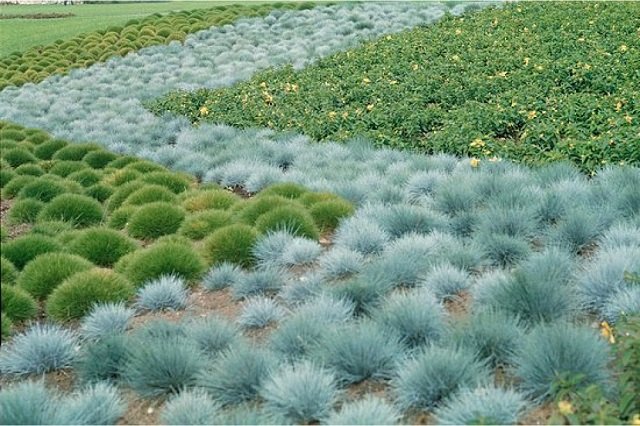
- The lush bush of fescue has a straight stem, reaching a height of 20 to 60 cm and narrow, modified leaf blades. This device - leaves twisted into a thin tube, allows the plant to significantly save water consumption during the evaporation process. Linear evergreen leaves form spherical, dense, beautiful bushes. perennial rhizome small sizes but thick enough.
- The fescue inflorescence is represented by a panicle with inconspicuous small, light brown flowers. The flowering period of oatmeal falls on June-July. Then, the bush throws out straight peduncles with inconspicuous spikelets of inflorescences, slightly rising above the bumps. During this period, the bush acquires a special lightness and airy structure. The seeds formed after flowering are very small.

- The life expectancy of a plant in one place without a transplant, as a rule, is from 5 to 10 years. Therefore, after 5 years, curtains are recommended to be divided and transplanted. And in case of deterioration appearance fescue (drying, freezing), this can be done earlier.
- This type of ornamental grass prefers sunny and open areas with light, sandy, well-drained soil.
- Low-growing varieties of gray fescue are widely used as a groundcover on garden plots. Moreover, the more bushes are planted in the flowerbed, the more optimally the decorative task of this ground cover perennial is performed. The amazing effect of "fluffy hedgehogs" planted in a row is also associated with useful functions: preventing the drying of the soil and the development of weeds.
- The taller members of the genus are also very popular in the field of landscape design, due to their exquisite decorative qualities that persist throughout the season.
Gray fescue has many varieties that differ in the main morphological features: the height of the curtain, the size and color of the leaves.

Varieties of fescue gray
Varieties of gray fescue differ slightly from each other and often have several names for the same variety. The color scheme of the bushes varies from pale blue and silver to deep blue, with a metallic sheen, shades.
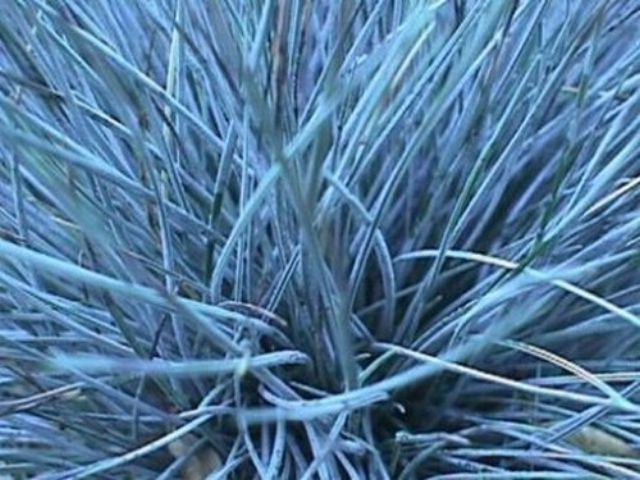
- Varieties "Azurit", "Silberreiher", "Blausilber" are characterized by blue-silver leaves.
- Variety "Meerblau" is distinguished by the curtain color of sea water.
- The Daeumling variety has a low, compact, rounded shape of a bush, about 15 cm high.
- Varieties "Blaufuchs", "Fruhlingsblau", "Blaufink", "Blauglut" have silver-blue leaves.
- The variety "Seeigel" is characterized by leaves of blue-green hues.
- Variety "Soiling" is distinguished by the gray or ashy color of the modified leaves.
- The Festuca cinerea variety is very popular among gardeners. A lush blue-green bush reaches a height of up to 60 cm.

Fescue breeding
The most simple and convenient way fescue breeding - vegetative.
- To do this, in early spring or autumn, a strong overgrown fescue bush is divided into several parts.
- Thus rejuvenating the old uterine curtains, young bushes are planted.
- When propagated in this way, the dried core of the plant is not suitable as a seedling, it is simply removed.
Also practiced seed way reproduction of specific varieties of fescue, in which either seeds are sown, or seedlings that have appeared after self-seeding of the plant are used.
- For self-collection of seeds, ripened large spikelets are selected, carefully cut off, dried, and only then the seeds are removed.
- You can also buy gray fescue seeds and specialized local outlets. It is important to purchase varieties that are already acclimatized to the conditions of a particular area, with a certain level of frost resistance. This is due to the fact that some varieties have an insignificant level of frost resistance and, if the crop is not adapted to a certain climate, problems may arise with the freezing of the plant.
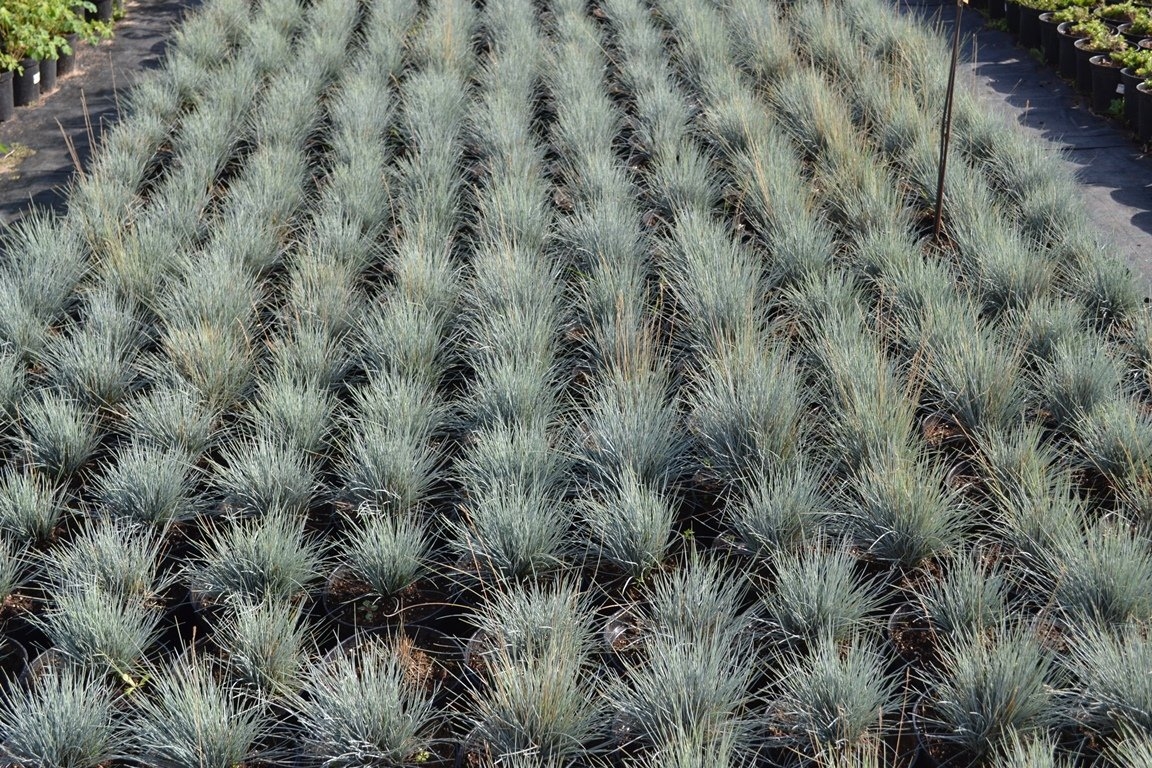
Gray fescue, planting
Knowing the breeding characteristics of gray fescue, you can easily increase the amount of this extremely decorative grass in your area.
Planting a plant, as well as the process of reproduction, is not a complicated and time-consuming procedure. It is enough to follow the basic technological methods when growing this cereal perennial.
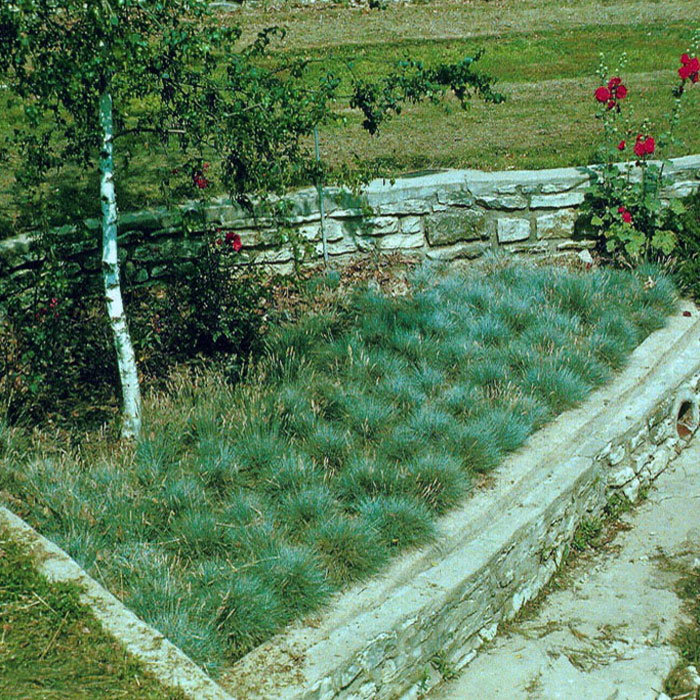
Gray fescue. Selecting a landing site
- The most successful place for planting heat-loving fescue will be an open, sunny and warm area, without drafts.
- You should not plant a plant near tall "neighbors", shading and, thereby, inhibiting the growth of culture. Shading negatively affects the color of the plant, the leaves of which become greener and lose their unusual decorative appearance. But, in the sun, on the contrary, the bumps acquire a more saturated, bluish-gray color.
- The soil is better to choose light, slightly nutritious (although this is not necessary), without stagnant moisture.
- Dampness adversely affects the plant, so it is better to provide the landing site with an additional drainage layer.
- You can enrich the soil that is completely meager in composition by mixing the earth with humus, peat, ash and sand. But to be zealous with fertilizers and top dressings - one should not, paradoxically, but fescue grows well on low-nutrient and dry soils. Often, when decorating a flower bed, decorative gravel or stones are used, where the fescue trees also feel great.

Gray fescue. Seed planting technology
- Seeds are sown both in open ground and under seedlings, in containers.
- Before planting, the seeds are treated with a weak solution of potassium permanganate.
- In order for the sown seeds to form a lush and dense fescue tussock as quickly as possible, it should be sown thickly, according to the "nest" principle, when 5-7 seeds are placed in one hole.
- Holes for seeds are made shallow, no more than 5 cm.
- After planting, the holes are covered with soil mixture, lightly tamped and watered.
- The distance between the holes can be different, on average, from 10 to 20 cm.
- Gray fescue seeds are sown in the spring, when the weather is warm, or in the fall, before the onset of cold weather.
- The first shoots appear in a few weeks, which quickly turn into lush bumps.

Gray fescue. seedling planting technology
- Provided that the seeds are sown, for seedlings in the first half of March - by May, the planting material will be ready, strengthened and grown.
- If sowing is carried out in containers, the seeds are sown on a light soil substrate, without sprinkling them, but only moistening them with a spray bottle.
- Then the box is covered with film or glass, placed in a warm and lit place. In such a greenhouse, seedlings appear in a few days.
- To avoid thinning and lodging of seedlings, the container is moved to a cooler, but still bright place.
- It is necessary to transplant seedlings into separate containers provided that at least two leaves are formed. Seedlings are transplanted in groups in order to get a lush bush in the future.
- In the spring, when stable warm weather is established, the grown seedlings are planted in open ground.
- Growing seedlings, you should carefully consider moisturizing, avoiding excess moisture and rotting of the root system.

Gray fescue. Planting technology part of the bush
- The fescue uterine bush is divided for subsequent seating, in spring or autumn.
- You can divide an adult bush if it is more than two years old.
- Separate parts - delenki, are planted in prepared holes.
- This method of reproduction can be improved by additionally "hardening" the mother bush. To do this, for the winter, the plant is transplanted into a container, which is placed in a cold but well-lit place (greenhouse). It is important to ensure that there is no dampness in the greenhouse so that the plant does not rot and die. In early spring, the bush is divided into parts and planted in separate containers with a mixture of earth, humus and sand. Planted at the beginning of summer, the divisions of this bush will be much stronger and will be able to quickly gain deciduous mass.
Fescue is a fast-growing plant that grows not so much in height as in breadth. This feature allows very short time to acquire the necessary spectacular decorative appearance for the culture.

Gray fescue, care
By observing the elementary agrotechnical rules for caring for fescue, it is easy to achieve a beautiful and healthy plant in your area. Unpretentious and hardy culture does not need any special care, perfectly tolerates hot and dry weather, unpretentious to soils.
Pruning gray fescue
- In the spring, after the winter cold, the bush is cleaned of dead leaves to give the plant an aesthetically pleasing look. attractive appearance. This simple manipulation is done manually or with a thick rake.
- In the summer, after flowering, in order not to spoil the decorativeness of the perennial, many gardeners remove all flower stalks with panicles. If it is necessary to collect seed material, leave a few of the largest peduncles, the panicles of which are collected after final maturation.
Watering gray fescue
- Fescue is a drought-resistant plant that does not tolerate stagnant excess moisture. First of all, with an excess of moisture, the roots suffer, begin to rot and die.
- Therefore, watering should be carried out moderately, as needed. In this case, the rule will be appropriate: it is better to “not top up” than to “pour over”.
Transplanting gray fescue
- One of the drawbacks of the culture is the periodic degeneration of the old bush, when the middle of the curtain dries up and dies. In such cases, every 2-3 years, the bumps are rejuvenated: by dividing them and transplanting them to a new place.
- Transplantation has a beneficial effect not only on the condition of the fescue leaves, but also on the intensity of their color. They again acquire a beautiful silver hue, shine and the necessary density.
Preparing gray fescue for winter
- Grown and acclimatized plant is not afraid of winter low temperatures. Even if some leaves freeze, they are removed in the spring, and the bush restores its leafy mass with renewed vigor.
- The only thing is that during severe snowless winters, in order to prevent the bushes from freezing, you can cover the bumps with straw, fallen leaves or peat.
- It is noteworthy that young (1-2 year old) plants are much more cold-resistant than their "older counterparts". This is due to the gradual death of tussocks with age and, accordingly, the protective properties of the plant weakening every year.
Top dressing of gray fescue
- Gray fescue grows well on any soil: sandy, loamy. Only in cases of deterioration in the growth and development of a crop associated with excessive scarcity of the soil composition, additional fertilizers can be used.
- Apply mineral or organic fertilizers it is necessary according to the instructions, in no case, without exceeding the permissible dosage.
Diseases and pests of gray fescue
- Gray fescue almost never gets sick and is resistant to various kinds of pests. This valuable quality also attracts gardeners.

The use of fescue gray
Most often, gray fescue is used as ornamental grass for landscaping and decorating the landscape gardening area.
Unusually beautiful grass is planted in flower beds, along borders or fences, on alpine slides or in mixborders.

Sometimes, a small accent in the form of a chic fescue bush, in a rock garden or against a background of gravel, creates a unique effect of naturalness and appropriateness of planting.

Low-growing and compact tussocks are widely used to create carpet flower arrangements and various panels.

And mass plantings of fescue impress others with an unusual texture and color scheme.
Designers - gardeners skillfully combine plants with different colors of foliage. Gray fescue, having a characteristic silvery-ashy hue, stands out perfectly against the background of rich green cultures.
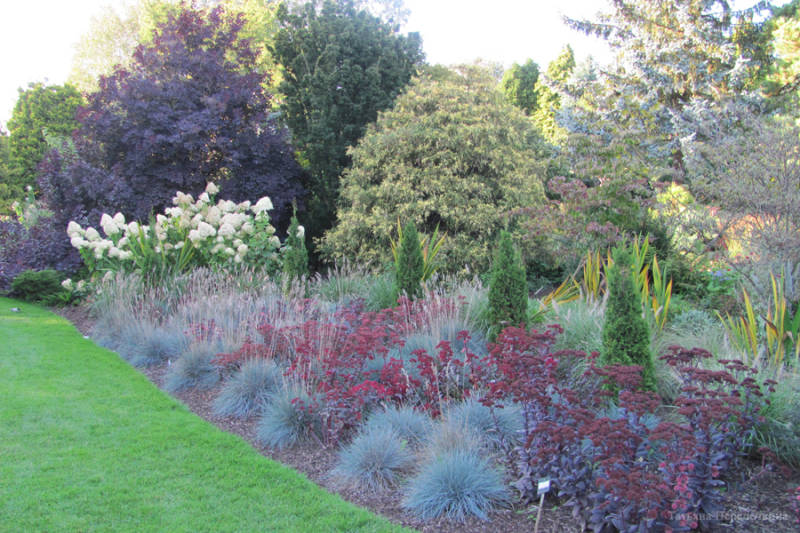
By planting cereals in an array near undersized cuffs, tradescantia or lungwort, it is possible to emphasize the beauty of blooming cultivated plants, resembling a "bright picture in a frame" of small gray fescue curtains.
In partnership with tall flowers, such as volzhanka or miscanthus, on the contrary, mass plantings of fescue create a gently silvery background, against which these flowers look even more impressive. beautiful flowers- large sizes.
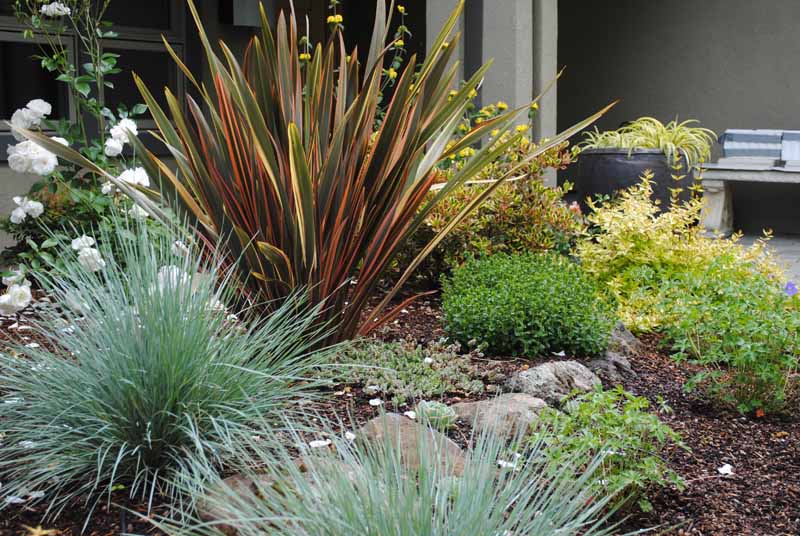
Often, landscapers combine plantings of fescue with coniferous evergreen flora to complement these crops and emphasize the richness of natural resources.

The original combination of colors will be the neighborhood of gray fescue and plants with pink or burgundy leaves: barberry, cannes, geyher.
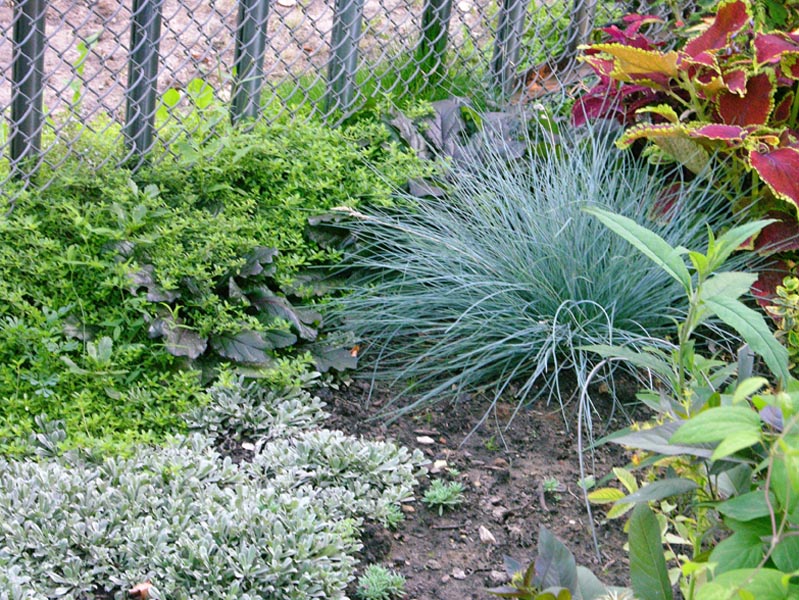
They also practice planting fescue in decorative baskets or pots as a single plant, and together with flowering summer crops.
The perennial is also used in dried form, to create ekibana or dry bouquets.
When planting a gray fescue in a flower bed or in the garden, even a novice florist will choose a suitable place for her, because it is simply impossible to spoil any composition with this plant. Complementing other cultures or declaring individually about itself, fescue will become an invariable decoration of any site.
So, having become acquainted with the "simple" technology of planting and caring for a crop, anyone who wants to cope with the task. And to facilitate the process, the weighty advantages of fescue are called upon - unpretentiousness, endurance, immunity to diseases and pests. The result will not be long in coming and, soon, will delight others with an unusually attractive decorative look.
Gray fescue, photo
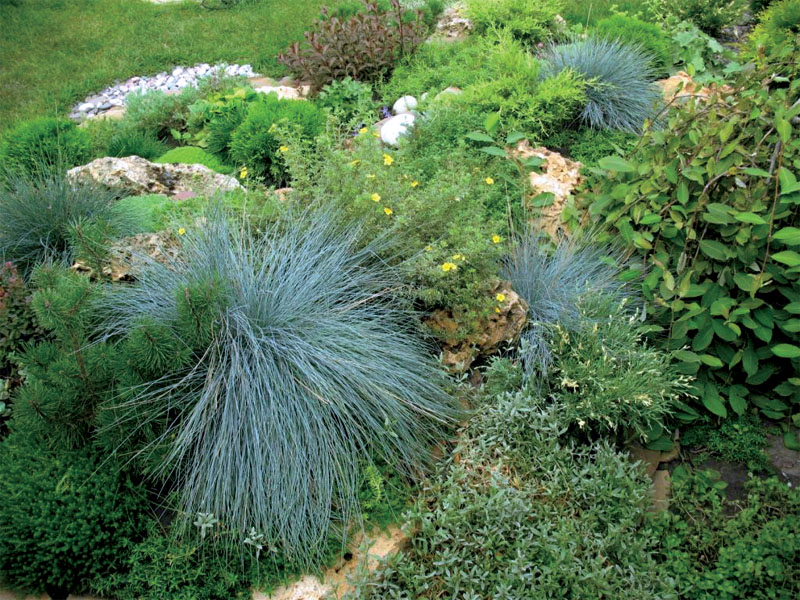


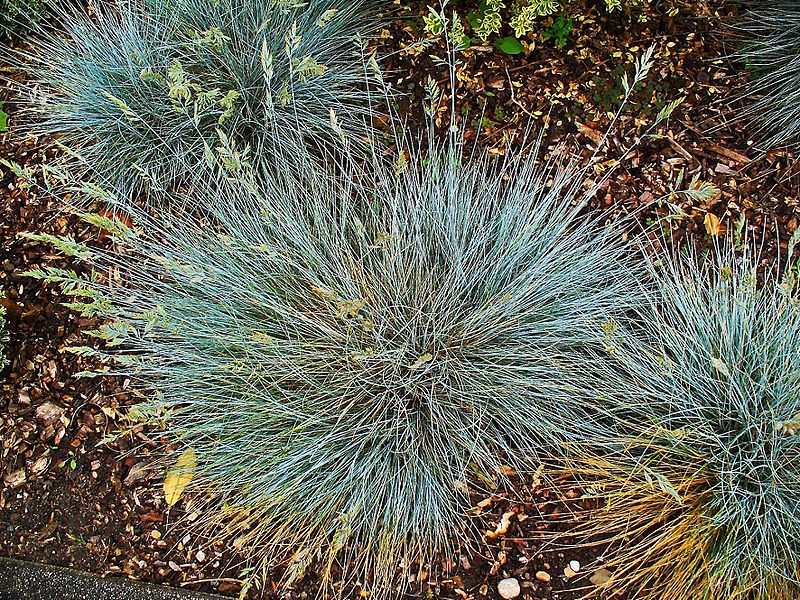

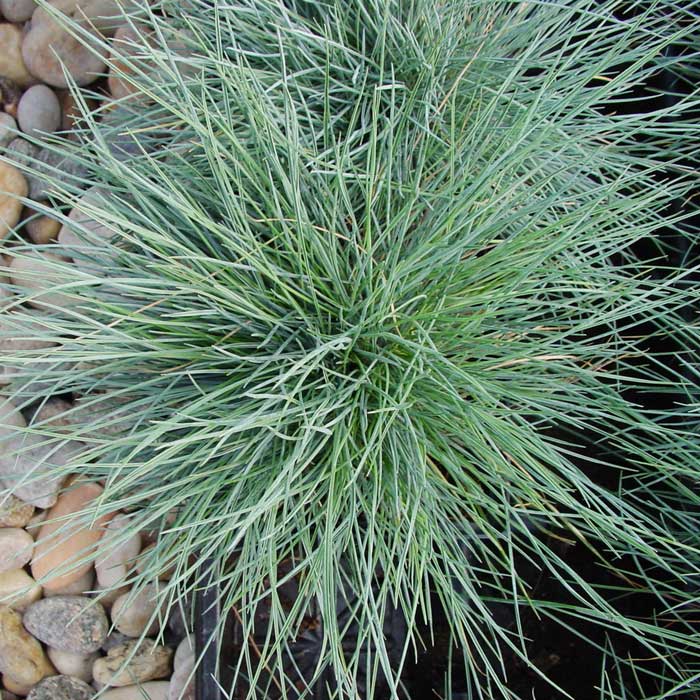
It is a compact hemispherical undersized bush of the original form.
An interesting color, coupled with the plant's endurance and unpretentiousness, allows it to be a favorite. landscape designers and people who want to arrange beautiful landscape compositions in their garden.
Gray fescue: description
Fescue is usually attributed to the Cereal family. Distribution in nature - temperate and subtropical zones. As artificial plantations, the plant "dispersed" in all climatic zones northern to tropical. Of all the types of fescue, it is gray-gray that is most loved by garden designers, both professionals and amateurs. Thanks to the color of the leaves, the plant got its name, its variants: ashen fescue, blue. Depending on the weather conditions the color may change, but the plant does not lose its decorative effect.
Did you know? Fescue trees had their name "festuca" in ancient Roman times, but its true meaning did not reach contemporaries. The popular name "fescue" appeared due to the similarity ornamental bush with a plant of the same family - sowing.
The plant is a lush bush with a height of 20 to 60 centimeters, the leaves are narrow, twisted into a tube. Modified in this way, they save water. leaves form round dense bushes. The roots are dense, small in size.
It blooms in early or mid-summer with inconspicuous light brown small flowers. Formed after flowering are very small. Without transplanting in one place, fescue can grow for 5-10 years. Divide and transplant curtains after five years; if the plant dried up or froze, then earlier.
As a soil cover in order to protect it from drying out and fescue - perfect option. Serving this purpose, it creates a unique decorative effect that lasts throughout the season.
There are many garden forms fescue, they differ in foliage and color.
Growing conditions
Fescues are great lovers of the sun, almost all of them are cold-resistant and are not afraid of frost. It is advisable to buy specimens bred in the area and acclimatized to its conditions so that there are no unpleasant surprises after the winter season. The disadvantage is that curtains degenerate rather quickly. After two or three years, the plant has to be divided, because the center of the sod dies off. The advantage is that it grows quite quickly, diverging in width, and already in the first year it acquires a dignified appearance that can decorate any part of the landscape with its sophistication.
sunlight
The fescue will be grateful for the hottest parts of the garden where it feels great. She is not afraid of high temperatures - gardeners use this property, settling her on alpine hills on the south side. Plants that also love sunlight include,. The plant is not friendly with a shadow or even partial shade, and it also does not tolerate drafts. You should not take risks and plant light-loving "hedgehogs" in unsuitable conditions for them. Without light, they can lose their beautiful blue color. 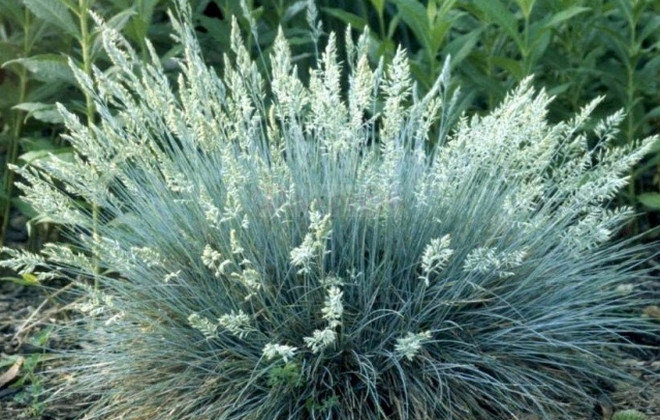
soil for growing plants
it unusual plant does not require the presence of humus or other nutrients. The soil should be dry or fast drying, loose and breathable. Under no circumstances should there be standing water. Often additionally used.
Fescue does not need nutritious soil, regular, caring top dressing. Best of all, she will feel on stony, dry soil. Only under conditions suitable soil and plentiful sunlight this plant will thank its owner with a beautiful bluish color, abundant flowering and exquisite unusual type of bush.
Terms and rules of landing
As the fescue itself is unpretentious, so is the process of planting it. Compliance simple terms will ensure success in cultivation.
Gray fescue reproduces mainly vegetatively; cultivation from seeds is also practiced. 
seed propagation
The seed method of reproduction is used for specific varieties. In this case, the seeds:
- sown in the ground;
- planted on;
- use plants resulting from self-sowing.
Important! Fescues planted in the ground and seedlings grown in seedlings take root equally well, but the first ones will germinate somewhat faster.
If you decide to purchase seeds to plant funny "hedgehogs" in your garden, you should give preference to specialized outlets. 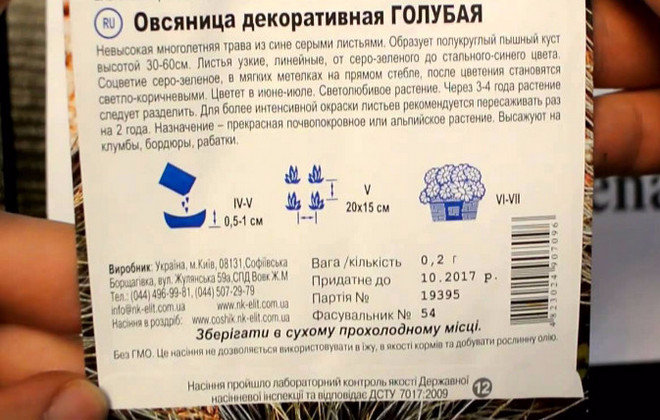 Sowing should be chosen from those varieties that are acclimatized to the area and have a certain level of frost resistance. Important! Only natural species can be propagated by seed. Fescue bred artificially, with this method of reproduction, lose the signs of the variety.
If this rule is neglected, there is a risk of resulting in a plant that is not adapted to local conditions, which will freeze out after the first wintering.
Sowing should be chosen from those varieties that are acclimatized to the area and have a certain level of frost resistance. Important! Only natural species can be propagated by seed. Fescue bred artificially, with this method of reproduction, lose the signs of the variety.
If this rule is neglected, there is a risk of resulting in a plant that is not adapted to local conditions, which will freeze out after the first wintering.
Planting seeds produced after warm weather in spring or before cold weather in autumn.
- Before planting, seeds that were collected on their own must be pickled in a solution of potassium permanganate. If you purchased your seed from a reputable retailer, especially if the packaging says pre-treatment, this is not necessary.
- 5-7 seeds should be planted in each hole so that they quickly form a lush bump.
- The hole should not be too deep, a maximum of 5 centimeters.
- After planting the seeds in the ground, you need to fill them with soil mixture, compact and water.
- The spacing between the holes can be from 10 centimeters, depending on the desired result.
- After the appearance of the first shoots, which will appear in a few weeks, semicircular lush bumps will form very soon.
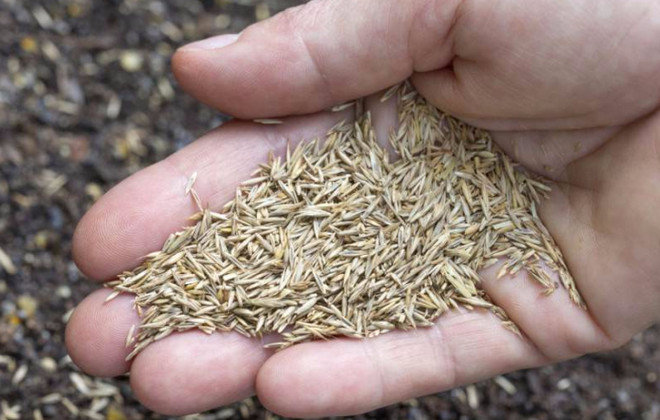 Planting seeds for seedlings occurs in early March, in order to plant stronger and grown bushes in the first half of May.
Planting seeds for seedlings occurs in early March, in order to plant stronger and grown bushes in the first half of May. - The substrate must be light, air and water permeable; when sowing seeds, do not sprinkle them, but moisten them with a spray bottle.
- Having covered with cellophane or glass, the container should be placed in a warm, bright place. This will allow the seedlings to hatch in a few days.
- So that the seedlings do not become thinner and do not die, the container will need to be rearranged to a place where it is cooler, however, it should be light.
- After the formation of two true leaves, the seedlings dive in groups into separate containers to obtain a lush bush.
- After the weather settles, most often this happens during the May holidays, the seedlings need to be planted in the ground.
Important! Humidification should be treated with great caution: excess moisture will lead to rotting and death of the roots.
Vegetative
Most often used vegetatively reproduction during transplantation and separation of overgrown bushes. 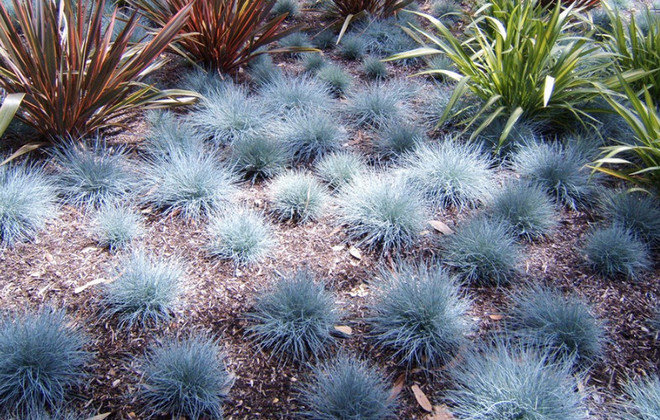 This should be done either in the spring before the start of the juice circulation, or in the fall, when the plants are preparing for winter.
This should be done either in the spring before the start of the juice circulation, or in the fall, when the plants are preparing for winter.
- Bushes that have grown a lot, and it's time to plant them, should be divided into parts.
- The resulting divisions must be planted as independent plants.
- The core, which has become unusable and due to which the decorative appearance of the entire bush has been disturbed, is removed without using.
Important! Share adults, not less than two years of age, bushes.
To give the plant additional winter hardiness, the mother bush should be dug up with a clod of earth, planted in a container and placed in a lighted but cold place, for example, a greenhouse. In this case, any dampness should be excluded in order to avoid the death of the bush.
At the beginning of spring, when the time comes to plant fescue, the curtain is supposed to be divided, the divisions should be planted in containers in a mixture of earth and sand. They should be planted in the ground in early summer. Having undergone such hardening, they will be much stronger and gain green mass faster. 
How to properly care for a plant in the garden
Gray fescue has many advantages: not only is it completely undemanding to soils, it tolerates both high and low temperatures, it almost does not need watering and top dressing, and it is not difficult to maintain the decorative appearance of the bush. Important! The immunity of fescue is very strong, separately growing specimens practically do not get sick. It is not uncommon, however, when "neighbors" in the lawn mixture or decorative composition infect a silver bush.
Undoubtedly, gray fescue is one of the leaders among unpretentious and at the same time ornamental plants, planting and caring for which are minimal and do not require special knowledge. 
Watering
Excess moisture is something that absolutely cannot be allowed in the care of fescue. The roots begin to suffer: they rot and die, as a result of which the whole plant dies.
Watering the bushes should be very moderate, only if necessary: let it be better to have little water than too much.
Important! Fescue tolerates winter frosts well, its main enemy is autumn and spring waters, leading to rotting of the roots. Snowless frosty winter is also dangerous for her.
Fertilizer rules
Fescue is completely undemanding to soils: it likes loamy, stony, sandy.  Only in case of extreme need for nutrition, when the plant has become worse to grow and develop, is it permissible to additionally fertilize the soil in which it grows.
Only in case of extreme need for nutrition, when the plant has become worse to grow and develop, is it permissible to additionally fertilize the soil in which it grows.
Fertilizers are applied organic or mineral, the dosage indicated in the instructions must not be exceeded. An excess of nutrients can adversely affect the decorative perennial. You will be interested to know more about and fertilizers.
pruning
When spring comes, the cereal must be rid of worn-out leaves and dead fragments, which will improve the appearance of the ornamental plant. This can be done both manually and with a rake, which, due to the rigidity of the leaves, will not damage the aesthetic component. After the bush has faded, you need to cut the flower stalks to preserve the appearance. In the case when you need to collect seeds, you should leave the largest flower stalks until fully ripe.
Gray fescue is a real decoration of any garden, which is quite easy to grow even for a beginner. The plant is hardy: it resists high temperatures with dignity, while being frost-resistant. Growing conditions and care are minimal. The disadvantage is the impossibility of planting fescue in shaded areas, besides, it does not tolerate dampness. If the plantings are large, caring for them can be quite laborious, due to the need to periodically separate and rejuvenate the curtains.
Was this article helpful?
Not really













